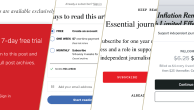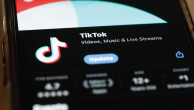The study, Digital Advertising and News, contains two main elements: The central research study conducted and written in-house by PEJ researchers and an accompanying essay by Professor Joseph Turow, Ph.D., Robert Lewis Shayon Professor of Communication at the University of Pennsylvania’s Annenberg School for Communication. Professor Turow is an expert in media fragmentation and author of several books including the newly released, The Daily You: How the New Advertising Industry is Defining Your Identity and Your Worth. Professor Turow’s full bio is below.
For the main research study, the primary PEJ staff members working on the report were research analyst Katerina-Eva Matsa, research analyst Kenny Olmstead and Deputy Director Amy Mitchell. Sovini Tan helped conduct the research. Dana Page, communications and creative design manager, managed publicity. Tricia Sartor created the visuals and Molly Rohal copy edited the report.
The Universe
[i]
Capture and Phase I Coding
The initial phase of coding measured the mix of advertisement and style of ads across both traditional media and their website counterparts. For one week in June 2011 three coders from PEJ coded a mix of ads in each outlet according to the following schedule:
Legacy outlets: For Cable and Network TV, each show being studied was captured and coded one day during the week of June 28thth-July 1st, 2011. Newspapers followed the same pattern. The full print edition of each paper was coded by one coder on one day of the same week.
For the news magazines which do not publish daily, the timing was slightly differently. For The Atlantic, a monthly publication, the June/July issue was coded. For the Economist, Newsweek, and Time Magazine the week of June 28thth-July 1stwas coded.
All ads appearing within the program or publication were captured and coded.
Websites: The websites for Network TV, Cable TV and Newspapers were coded on the same day that the traditional outlet was coded. For news magazines the corresponding week was coded. (For the Atlantic only June 29th which was the Wednesday of the week of June 28thth-July 1st was coded, despite the magazine covering all of June/July in its print edition.) For the website of each outlet the homepage and the first five stories on the site were coded.
Each ad that was captured according to the criteria above, was coded for the following variables:
Broad Topic of the story associated with the article- Determines the type of broad topic categories addressed by a story such as crime, education, economy, etc.
Placement- Designates where ads are located within a publication, on a website, or within a broadcast. The location reflects whether an ad is in the front page of a publication and website or the pages connected to the news stories. Also, the location reflects whether the ad is in the first, second etc. natural break of the broadcast.
Size/Type of the Ad- this code determined the size or length of the ad. For newspapers it was how much of the page the ad took up, full page ad, half page, etc. For broadcast ads it was the length of the ad, 30 seconds or more than 30 seconds. For online ads it reflected the location of the ad, including if the ad was a pop up ad or a roll down ad (also referred to as the window shade ad).
Format of the ad- this applied only to online ads and it determines the type of online ad, static banner, rich media, video, sponsored ads or sponsored link boxes.
Ad category- this variable reflects what the ad was for, for example an ad for a car would be coded as “automotive”.
Company name- determines the name of the company in the advertisement.
Ad describer- Here the coder inputs a short description (approximately 5-15 words) of the content of each ad. The purpose of these describers is to examine whether an industry would use different ads for targeted audience.
Discount ad- Designates whether Groupon or other similar ads or coupon offers appear.
Part of an advertorial- applies only to magazines. This code determined whether the ad was part of an advertorial-an advertorial is a multi-page ad in a magazine that is formatted like a story but is sponsored by a specific product and the “story” is really about the product and not produced by the publication.
Phase II Coding:
The second phase of coding was to determine the level of targeting for online ads. For this phase each website was coded by two separate coders. Each coder coded the site 2 times, for a total of 4 passes on each site.
For the first round of coding on a site a coder would use the regular web browser he or she uses to surf the internet on a daily basis. For the second phase the coder would use a “clean” browser, or one where the cookies/history/cache was cleared and the coder was signed out from any personal accounts, such as Google, email and/or subscription accounts. In addition in the second phase the cookies/history/cache was cleared every time before a new site was coded. The purpose of this was to determine the level of targeting each site has. By clearing the cookies/history/cache, PEJ was attempting to control for the most common ways in which sites target.
In order to determine the level of targeting the researchers applied three steps:
- a) For each website the researchers classified the ad categories that appeared for each user (both when the users used a “clean” browser or their own). Then, the researchers compared the ad categories between the two users and also those that appeared for the same user when coded through different browsers. In the case that the top four ad categories were identical for both users regardless of clearing their cookies/history cache, those websites were identified as low or no signs of targeting. In the case, that the ad categories were somewhat different, then the researcher employed an additional step.
- b) The researchers compared the ads that appeared for each user, according to the following variables: company name and ads describers. The ads that did not appear in both users were classified as different. The researchers calculated the percentage of the different ads out of the total number of ads that users received. The higher the level of “difference” the higher the targeting.
- c) Finally, throughout the process the researchers kept personal notes in regards to the ads that they came across. They identified the ads that seemed targeted based on their browsing history and then compared those specific ads to each other, to determine whether the other user also received those ads.
Targeting Follow Up
On January 27th, 2012 PEJ researchers revisited each site to check the levels of targeting. To do this 2 researchers went to each site using their regular browser and took screen shots of the homepage and the top five stories. Then the ads on each page were compared between the 2 researchers to determine if the level of targeting had changed. In general PEJ found that the level of targeting had not changed on the news sites studied, only two sites (latimes.com and theatlantic.com) showed slightly higher levels of targeting.
Outlets/Shows Coded
Cable TV
|
CNN |
Fox News |
MSNBC |
|
|
5 p.m. |
Situation Room |
—— |
—— |
|
6 p.m |
John King, USA |
Special Report w/Bret Baier |
PoliticsNation |
|
7 p.m |
Erin Burnett OutFront |
Fox Report w/ Shephard Smith |
Hardball |
|
8 p.m. |
Anderson Cooper 360 |
The O’Reilly Factor |
The Ed Show |
|
9 p.m. |
—— |
Hannity |
The Rachel Maddow Show |
|
10 p.m. |
—— |
—— |
—— |
Newspapers
The New York Times
USA Today
The Wall Street Journal
The Los Angeles Times
The Washingtonpost
The Hour
The Toledo Blade
Online Outlets
Yahoo News
Google News
HuffingtonPost.com
MSNBC.com
CNN.com
FoxNews.com
NYTimes.com
LATimes.com
USAToday.com
WashingtonPost.com
ABCNews.com
CBS.com
Wall Street Journal Online
Thehour.com
Toledoblade.com
Atlanta Journal Constitution Online
The Arizona Republic
St. Augustine Record
Time,com
Newsweek.com
TheAtlantic.com
TheEconomist.com
Network TV (Seven in all, Mon-Fri)
Morning shows – Code1 or 2 out of 3 every day
ABC – Good Morning America
CBS – Early Show
NBC – Today
Evening news
ABC – World News Tonight
CBS – CBS Evening News
NBC – NBC Nightly News
Magazines
Time
Newsweek
The Atlantic
The Economist
Footnote
[i]




